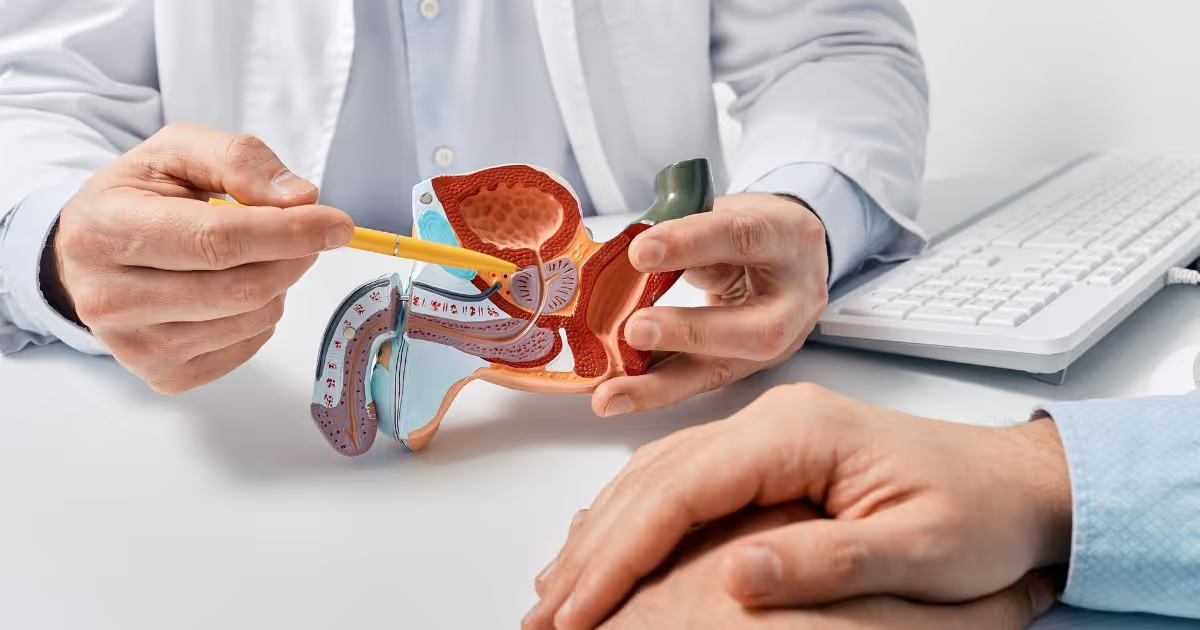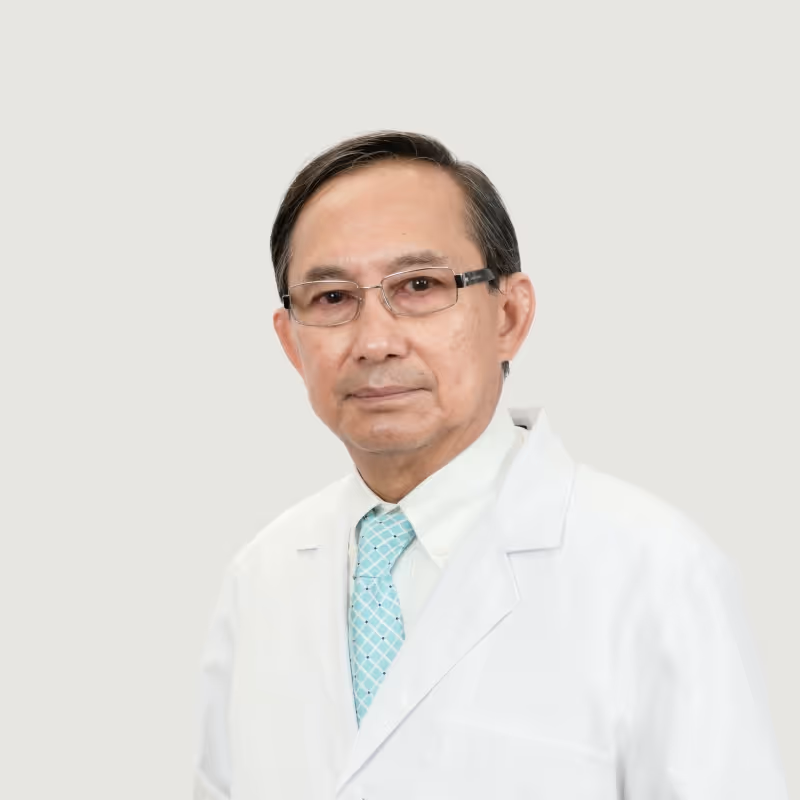Choose the content to read
- Prostate Brachytherapy
- What causes prostate cancer?
- What are the symptoms of prostate cancer?
- What is the diagnosis before determining prostate brachytherapy?
- What is prostate brachytherapy procedure?
- What is the side effect of prostate brachytherapy?
- Prostate brachytherapy at MedPark Hospital?
Prostate Brachytherapy
Prostate brachytherapy is an internal radiation technique for the treatment of prostate cancer. The procedure involves placing a radioactive source in a small capsule into the prostate gland to deliver high doses of radiation to kill cancer cells without damaging nearby healthy tissue or receiving only a low radiation level. The radiation urologist will search for the implantation site, assess the cancer size, and determine the radiation dose to confine the irradiated area to cancer cells. Prostate brachytherapy is considered a safe and efficient treatment without impacting sexual function and has the highest cure rate for early-stage prostate cancer.
Why prostate brachytherapy?
Prostate brachytherapy is used to treat prostate cancer. The procedure places radioactive sources within the prostate, so cancer receives most of the radiation, therefore close healthy tissue receives a minimum dose of radiation.
Prostate brachytherapy is the optimal treatment for early-stage prostate cancer. Prostate brachytherapy is a targeted radiation therapy that specifically targets cancer cells in a defined area, minimizing harm to healthy tissue and facilitating a speedy recovery. In contrast to conventional external radiation therapy, which exposes a broad spectrum of external radiation, has more exposure to normal tissue cells, and requires a much longer recovery period. Prostate brachytherapy is a minimally invasive yet highly effective treatment method. The treatment has fewer side effects or complications compared to other treatments, achieving a high success rate of up to 97% (stages 1-2). In addition, if the radiation urologist finds cancer cells have spread to other neighboring organs, he or she will consider other combination treatments such as teletherapy and anti-androgen medications to fight cancer.
What causes prostate cancer?
- Age: Increasing age, particularly males aged 50 and up.
- Genetics: Those who have a father, elder brother, or younger brother with prostate cancer.
- Ethnicity: African and European men have a higher risk than Asian men. Thai men tend to increase the number of new patients each year.
- Foods: Consistently consuming large amounts of red meat, high-fat foods, processed meat, and grilled smoked barbecue.
- Obesity: Excess weight or diabetes.
What are the symptoms of prostate cancer?
- Voiding small urine volumes
- Frequent urinating
- Urinary incontinence
- Urinary retention
- Decrease force of urination
- Frequently urinating at night
- Difficulty urinating
- Unable to void without straining.
- Experiencing pain while urinating or ejaculating
- Burning or painful urination
- Blood in the urine, blood in the semen
- Musculoskeletal pain
What is the diagnosis before determining prostate brachytherapy?
The urologist will diagnose prostate cancer by taking a history if there are symptoms of voided small urine volumes, pain while urinating, difficulty urinating, frequent urination at night, and other abnormalities, and perform a physical examination as follows:
Medical history
- When did the symptoms first appear—the level of pain, any associated symptoms, and/or the presence of blood in the urine?
- Medical history, underlying diseases such as obesity and diabetes, as well as medications and dietary supplements, are taken regularly.
- Family history of prostate cancer.
- Eating habits, smoking habits, and lifestyle.
- Stress
Prostate Specific Antigen (PSA)
- Determine the level of prostate cancer PSA, a type of protein in the bloodstream produced by prostate cells. A low PSA level may indicate early-stage prostate cancer. A high PSA level, on the other hand, may indicate advanced prostate cancer or a non-cancerous prostate disease, such as an enlarged prostate.
Screening Tests for prostate cancer
- Digital Rectal Exam (DRE)
- Transrectal Ultrasound (TRUS)
- PET/CT scan/PSMA PET Scan
- EKG/ECG (Electrocardiogram)
- Chest X-rays
- Complete blood count (CBC)
How many types of prostate brachytherapy?
There are 2 types of prostate brachytherapy. The urologist will determine the best treatment option for each individual based on the location, size, and stage of the prostate cancer, and whether the cancer has spread to other organs.
- High-dose rate brachytherapy (HDR) is a prostate cancer treatment in which high-dose radioactive sources are temporarily implanted into the prostate gland for 15-40 minutes, allowing radiation to release and destroy cancer cells immediately before the urologist carefully withdraws the radioactive sources from the body. The radioactive source used is Iridium 192, which has a half-life of approximately 74 days. The radioactive sources will emit gamma rays in a short period of time, with no effect on nearby organs. After the first treatment, the urologist will schedule the next prostate brachytherapy appointment for 4 sessions within 12 weeks until the treatment outcomes can be determined; the PSA level is less than 0.2 ng/mL, which is equivalent to a healthy person (less than 0.4 ng/mL). Once the cancer has been completely treated, the urologist will schedule a follow-up appointment for PSA test, MRI, or PSMA-PET scan.
- Low-dose rate brachytherapy (LDR) is a prostate cancer treatment in which low-dose radioactive sources are permanently implanted into the prostate gland, allowing radiation to gradually destroy cancer cells until they are completely gone. The used radioactive source is iodine-125, which will continue to destroy cancer cells over time. However, the LDR method will leave a small amount of radiation in the body for an extended period of time. As a result, the doctor now prefers high-dose-rate brachytherapy (HDR) to treat prostate cancer, which has produced positive results and has fewer side effects.
What is prostate brachytherapy procedure?
Prostate brachytherapy at MedPark Hospital adheres to the international gold standard for diagnosis and treatment, considering the utmost safety and effectiveness. The prostate brachytherapy procedure will take approximately 2 hours. The patient will stay in the hospital overnight to observe the symptoms and can return home the next day if there are no complications.
Pre-prostate brachytherapy preparation
- The urologist uses X-rays, ultrasounds, or CT scans to determine the location, stage, and size of prostate cancer in order to tailor an appropriate treatment plan, specifying the target location of the radioactive implant and calculating the radioactive seeds needed for the implant.
- The urologist will ask the patient to discontinue specific medications 1 week before surgery, including antiplatelet drugs, aspirin, ibuprofen, naproxen, and Plavix.
- Quit smoking and alcohol consumption.
During prostate brachytherapy procedures
- Before the surgery, the doctor explains the prostate brachytherapy procedure for treating prostate cancer and obtains consent forms.
- To avoid infection, the preoperative nursing staff cleans and disinfects the area where the radioactive seed insertion will occur.
- The anesthesiologist administers anesthesia to sedate the entire body to avoid pain in particular areas, including the perineum, anus, and scrotum, while delivering radioactive sources.
- The urologist inserts an ultrasound probe into the rectum, projecting real-time images on a screen and digitally recorded, allowing the urologist to clearly visualize the condition inside the prostate gland and the location of cancer, as well as calculate the dose of radiation used for implantation and determine the exact location where a radioactive source can be best placed to kill cancer cells accurately and precisely.
- The urologist inserts a series of thin needles connected to catheters of a brachytherapy machine to penetrate the perineum area and enter the prostate gland under rectal ultrasound guidance to help guide the implant of radioactive seeds into the prostate cancer site and effectively destroy the cancer cells.
- Once the implantation is completed, the urologist will gently withdraw the needle and catheter without the need to stitch the wounds or leaving any radiation left in the body, not impacting nearby people or the environment. The patient can live a normal life with their loved ones.
- Each prostate brachytherapy session takes approximately 2 hours. After the implantation is over, the urologist will schedule the next brachytherapy session.
Post prostate brachytherapy procedures
- The patient will stay overnight at the hospital for observation.
- The doctor and nurses periodically conduct post-treatment evaluations. If no abnormalities or complications are found, the doctor will allow the patient to return home.
What is prostate brachytherapy aftercare?
- Take the medicine and food prescribed by the doctor.
- Those experiencing unusual symptoms such as pain, swelling, bruising, nausea, vomiting, dizziness, or headache should seek medical attention right away.
- Stop smoking and consuming alcohol, as well as high-fat, high-sugar foods, processed foods, and large amounts of red meat.
- The urologist will conduct a post-treatment follow-up to assess the results of treatment and collect a blood sample to determine the PSA level.
- In the case of cancer recurring. The doctor will consider repeating brachytherapy in conjunction with radiation therapy using Volumetric Modulated Arc Therapy (Rapid Arc) and/or surgery to treat cancer.
What is the side effect of prostate brachytherapy?
- Swelling and bruising in the perineum, anus, and scrotum areas where the needles are injected.
- Difficulty urinating, urinary retention
- Pain or discomfort while urinating
- Blood in the urine or semen
- Frequently urinating at night
- Rectal bleeding, bloody stool.
- Urinary incontinence
Side effects of prostate brachytherapy vary from person to person. Some people may experience side effects from a variety of symptoms, while others may not exhibit any symptoms at all. Prostate brachytherapy has fewer side effects compared to other prostate cancer treatments, and many patients can regain urinary, intestinal, and sexual function as usual within 6–12 months of completing all treatment sessions.
What is the benefit of prostate brachytherapy?
- Minimally invasive: Prostate brachytherapy is a minimally invasive treatment characterized by tiny wounds, minimal pain, and rapid recovery. During the procedure, urologists use thin needles inserted into the perineum to guide catheters, delivering radioactive sources directly into the prostate gland without the need for surgery. This approach results in no surgical scars, completes the treatment in approximately 2 hours, and significantly shortens the recovery time.
- Precise targeting: Prostate brachytherapy is a treatment that clearly defines the exact location of the prostate cancer area and delivers the radioactive source to directly kill only cancer cells with the least exposure to surrounding normal tissue cells. Prostate brachytherapy is literally a targeted treatment that helps reduce side effects such as urinary incontinence without effecting sexual performance or causing sexual dysfunction.
- Dose-limiting: In prostate brachytherapy treatment, the doctor can effectively treat prostate cancer by calculating the appropriate amount of radiation in real-time through the screen using the ultrasound probe. This allows the doctor to use the least amount of radiation while still achieving maximum efficiency.
- Fewer treatment sessions: Over 3-6 months of HDR treatment sessions, the urologist will schedule only 4 sessions of prostate brachytherapy, unlike conventional external beam radiation therapy (EBRT), which requires daily external beam radiation for several weeks.
- High success rate: Prostate brachytherapy has a high success rate of up to 97% (for prostate cancer patients in stages 1-2).
- Quick recovery: After prostate brachytherapy treatment, the patient will stay overnight at the hospital for observation of the symptoms. The patient can stand, walk, and sit normally and can return home the next day.
What is the recovery time after prostate brachytherapy?
The recovery time after prostate brachytherapy varies depending on each individual's health. Typically, the patient will be able to walk normally for 2-3 hours after treatment. A non-strenuous activity can be performed within 2-3 days, and the patient can resume normal sexual intercourse within 2 weeks.
Prostate brachytherapy at MedPark Hospital?
Light of Day Radiation Oncology Center at MedPark Hospital is led by a team of experienced radiation urologists, as well as seasoned urologists and rehabilitation medicine doctors, with full readiness in diagnosing and treating prostate cancer with no cut operation for prostate cancer and other types of cancer, utilizing brachytherapy and other holistic treatment methods adhering to international standards approaches, using state-of-the-art medical technology and equipment, integrated with advanced specialized surgical techniques that are safe, fast, accurate, and precise, effectively reduces the chance of recurrence while providing post-treatment follow-up to reduce complications, shorten the recovery period, allow patients to recover quickly, and give them a chance to be cured of cancer permanently.















